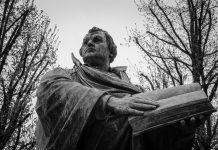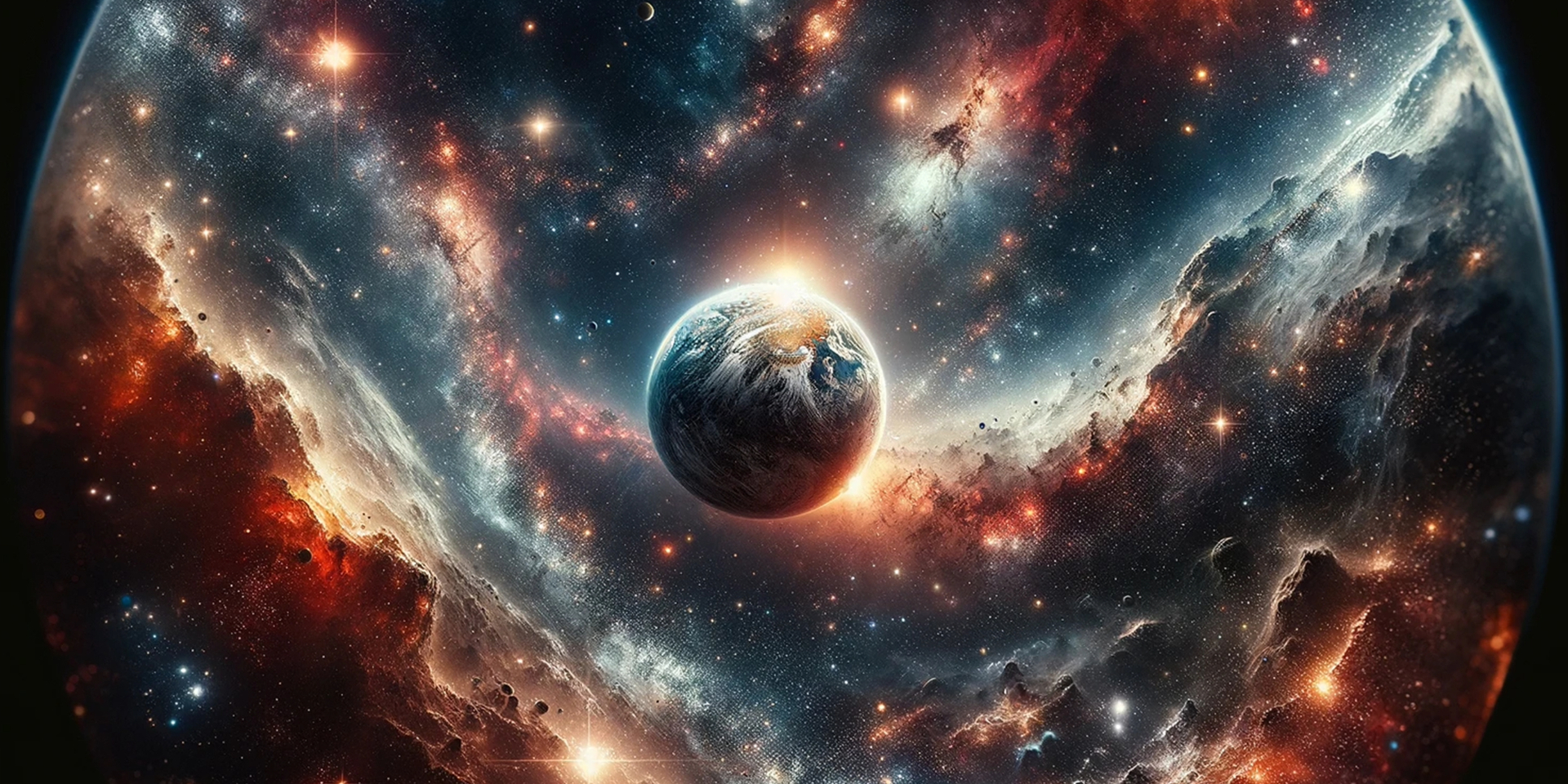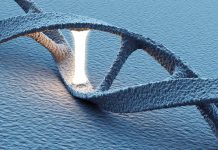At first glance, the idea that life could have emerged spontaneously seems to imply insurmountable probabilities. Indeed, simple yet accurate mathematical modelling reveals infinitesimal probabilities, regardless of the length of time available. So, how is the theory of evolution compatible with these mathematical arguments? Is the spontaneous emergence of life the only improbable aspect of the theory?
Around 3.8 billion years ago, immediately following the last major meteor bombardment, the Earth was barren and completely covered in water. Oceans had existed before, but giant meteor impacts would regularly vaporise them. Every few thousand years, the water in the atmosphere would gather in the oceans again and the process would repeat. It was only 3.8 billion years ago that conditions on our primitive Earth, and in our solar system in general, became stable enough to allow life to emerge. The planetary ocean provided an ideal environment for the complex chemical reactions underlying organic chemistry, which, over time, produced increasingly complex molecules. These reactions ultimately led to the spontaneous emergence of the first primitive living cell, which was capable of multiplying and passing on information—initially, most likely, only in the form of RNA.
This is the essence of abiogenesis, or the evolutionary narrative of the origins of life, which is widely accepted today.
In the beginning…
Charles Darwin was the first to think in these terms. He speculated that life most likely arose in warm ponds containing various ammonia compounds, phosphoric salts, and other organic compounds. Under the influence of heat and electrical discharges from lightning, among other factors, the first proteins developed, ready to accumulate and form increasingly complex structures.
The conditions on early Earth would have been completely different to those of today, which explains why abiogenesis cannot be achieved today.[1] Over time, this thinking evolved into the idea of a “primordial soup” of organic compounds in a planetary ocean, also known as the “prebiotic ocean”. This theory was developed by the biochemist Alexander Oparin and the geneticist JBS Haldane in 1924–1925, and the first experimental evidence to support it appeared in the famous Miller–Urey experiment in 1952.
Biochemists Stanley Miller and Harold Urey conducted an experiment in which a mixture of gases, primarily consisting of methane, ammonia, and hydrogen, was exposed to electrical discharges and varying temperatures. This produced measurable quantities of various monomers. Monomers are the building blocks of proteins. Proteins are the basis of the structure and function of all living cells, including DNA. Since then, neither Miller, Urey, nor anyone else, has produced life in a test tube—not even close. Nevertheless, the formation of monomers and subsequently various polymers, which they demonstrated could occur naturally, is the fundamental chemistry of life as we understand it today and the primary experimental validation of the concepts of primordial soup and the prebiotic ocean.[2]
These discoveries led Nobel laureate George Wald to express optimism in 1954 about the emergence of life over billions of years: “Given so much time, the ‘impossible’ becomes possible, the possible probable, and the probable virtually certain. One has only to wait: time itself performs the miracles.”[3] This is essentially the evolutionary thinking that still prevails today.
…something inconceivable
But is this “miracle” of the spontaneous emergence of life, proposed by Wald, mathematically analysable, probabilistic? It certainly is, and here are the results:
Hubert Yockey, a physicist and computer scientist at the University of California, Berkeley, estimated how long it would take for a specific protein to appear by chance on a planet where life had not yet evolved.[4] To do this, he assumed that this event could occur anywhere and at any time within a prebiotic ocean containing amino acids—the so-called “primordial soup” scenario. His calculations showed that it would take at least it would take at least 10²³ years for chance to produce that single first protein on the entire planet.
What does this number mean? Given that geologists propose the age of the Earth to be nearly 5 billion years, even this enormous figure is 10 thousand billion times smaller than the time needed to produce a single specific protein through random chemical reactions. Moreover, to form even the most primitive cell, an enormous number of such proteins in diverse specific forms need to come together in one place and, by chance, fall into a biologically functional configuration. And this wholly disregards the issues engendered by the fact that proteins are fragile chemical structures that can have diametrically opposed environmental requirements. A chemical environment that is conducive to one type of protein can be utterly destructive to other types of proteins, all types of proteins being indispensable simultaneously and located in the same place to form a cell.
Taking these factors into account in a way that favours the theory of evolution, Yockey concludes that the entire universe (not just Earth!) is 1,010,000,000,000 too small for the spontaneous emergence of a single primitive cell. This is an enormous number, beyond our ability to comprehend it.
One might object that the methodology used for the calculation is not the most appropriate, that the initial estimates may be inaccurate, or that the study is not recent enough. However, the message conveyed by these staggering orders of magnitude remains unaffected by relatively minor adjustments.
Whether we propose a few thousand or a few billion years, whether we limit ourselves to Earth or take the entire universe into account, the spontaneous emergence of life is probabilistically impossible!
However, let us see whether this radical statement can be proven by the results of other researchers.
Despite being an atheist and an evolutionist, the renowned British astronomer Sir Fred Hoyle did not shy away from rejecting the possibility of abiogenesis on Earth, deeming it impossible. He calculated that the probability of 2,000 proteins forming simultaneously is 1 in 10^40,000. And this was just for 2,000 proteins, not an entire cell.[5] To write out this number, we would need at least 13 pages. For comparison, the estimated number of atoms in the universe is “only” 10^80, a figure that could be written on two lines of a single sheet of paper.
However, other researchers have shown that Hoyle’s calculations may have been overly optimistic. American biochemist Harold J. Morowitz calculates the probability of a single primitive cell appearing spontaneously at 1 in 105,000,000,000, a number comparable to Yockey’s.[6] Morowitz is an evolutionist and is not discouraged by such probabilities. Instead, he promotes the idea that the energy flowing through a system is an important factor in the organisation of that system, suggesting that these astronomical improbabilities could be overcome. Nevertheless, the improbabilities put forward are almost inconceivable. In the face of such numbers, Chandra Wickramasinghe, a close collaborator of Hoyle’s, is credited with the following illustration, which has become emblematic of the problem of abiogenesis: “The chance that higher life forms might have emerged in this way is comparable to the chance that a tornado sweeping through a junkyard might assemble a Boeing 747 from the materials therein.”[7]
Panspermia, the multiverse, and the anthropic principle
Like Hoyle, Wickramasinghe is a proponent of an alternative theory of abiogenesis called panspermia. To increase the likelihood of life appearing spontaneously, it is hypothesised that life did not originate on Earth, but elsewhere in the universe, and was transported here (and possibly to other planets) via comets, meteorites, or cosmic dust. The problem with this theory is that the universe is not large enough to make the improbabilities it posits conceivable.
However, perhaps the answer lies not in our universe, but in an infinity of parallel universes, each with its own physical laws and fundamental constants, arising spontaneously and randomly. This is the multiverse theory. In this case, we and the rest of life on Earth would simply be the “lucky” inhabitants of a universe that is not only conducive to life, but also one in which life happened to arise. After all, it would be logical for us, as conscious observers of the world around us, to live in a universe that generated life. This is because the other universes have no observers to ask questions about the meaning of existence or the origin of life, because they do not allow life or have not generated conscious life. This, broadly speaking, is the anthropic principle, which is intertwined with the multiverse theory to provide the only seemingly plausible justification for naturalistic abiogenesis. However, beyond obvious tautological thinking, the problem with this perspective is that it provides a free pass to justify any observation (or lack thereof) in nature. Therefore, the theory is not falsifiable in the sense that a scientific theory should withstand experiments that test it.
Furthermore, apart from speculation, there is currently no evidence to support the multiverse theory.
However…
The evolutionary scientific community ultimately accepts that all these probabilistic problems associated with abiogenesis have only a partial solution today, but potentially a complete solution in the future. This solution is certainly naturalistic, although it is yet unknown. Regardless of whether the first cell appeared on a lucky Earth or in a lucky part of the multiverse, if Darwinian evolution is accepted as fact and God is not an option, then at some point non-life must have become life. Whatever the probabilities, we exist, so abiogenesis must have happened—this seems to be the basic philosophy of evolutionism.
Today, there are sophisticated attempts to “sweeten” the astronomical improbabilities on the path from non-life to life as much as possible, by looking for all kinds of plausible intermediate states that could produce the components and equipment of that first primitive cell. The “Origin of Life” page on the “Talk Origins” website provides an excellent introduction to this topic. Fortunately, any chemical and environmental conditions that could facilitate the process can be imagined, and the protocell does not have to be very complex, as single-celled organisms are today. It is considered sufficient for it to have a membrane, a minimal set of enzymes, and an RNA-based data storage and replication centre[8] in order to constitute the first biological unit capable of self-replication. From there, evolution through natural selection takes over.
Evolutionary thinking does not necessarily regard abiogenesis as part of evolutionary theory, but rather as the sole obstacle that, once overcome by the emergence of the first primitive cell, enables the entire evolutionary process to begin. In other words, strictly speaking, the theory of evolution does not refer to abiogenesis, but only to the evolution of life “after” its appearance, however it occurred.
The problem of abiogenesis is so challenging for evolutionists because they cannot invoke the almost magical mechanism that assists them in similar situations involving impossible probabilities in the general process of evolution: natural selection. Mutations and spontaneous changes in any biotic or prebiotic system are random, but natural selection is considered to be the exact opposite of randomness. As we saw in the previous article, “Can we simulate evolution?”, it is the force credited with the power to overcome any improbabilities. However, natural selection can only act on biological entities capable of self-reproduction with variation, rendering it powerless in a prebiotic soup, even one as large as the Earth itself.
Still…what would happen to theology and the beliefs of many if it were discovered in the not-too-distant future that not only are molecules and organic reactions ubiquitous in the solar system (or even the universe), but bacterial life also exists or has existed on nearby celestial bodies (such as planets, asteroids, and comets)? What if a team of researchers one day announced to the whole world that they had created a simple, entirely artificial living cell? Such events are hypothetical for now, but they would probably shake the foundations of the belief held by many that life is a miracle that cannot arise on its own (although the creation of artificial “primitive” life, and the possibility of widespread life in the universe do not solve the problem of naturalistic abiogenesis). But perhaps abiogenesis is not the greatest probabilistic problem of evolution by natural selection…
From cell to elephant
As we have pointed out, the theory of evolution acknowledges the improbability of a simple living cell emerging from non-living components. However, it considers the subsequent “evolution” of that cell into, for example, an elephant to be simply a matter of time, even if it takes billions of years. So how can the emergence of a microscopic cell be considered a much more improbable event than its transformation into an enormous, complex organism made up of billions of closely coordinated cells?
The theory’s answer to this apparent paradox is natural selection. Natural selection provides the theory with a mechanism that enables it to rationalise the structuring of chaotic and arbitrary variations into increasingly adapted and complex forms. This complexity ultimately refers to the genetic information stored in DNA. Thus, it is assumed that major problems such as the improbability of new information emerging, the complexity of existing information in the genome, and other challenges would be overcome through small steps of continuous adaptation. However, even accepting this premise, several shortcomings arise.
Firstly, over 95% of a species’ genome (we have chosen a general, approximate, but representative percentage) does NOT evolve through natural selection, but rather through genetic drift, as detailed in a previous article on population genetics. Of course, this refers to the part of the genome that is considered non-functional. However, it still evolves synchronously and coherently with the functional parts of the genome, albeit without any involvement of natural selection. Genetic drift essentially means modelling processes dominated by pure chance; it therefore involves the same probability issues as abiogenesis, but on a much larger scale.
Then, for the remaining 5%, evolution through natural selection must occur at species level rather than at individual level, where single mutations occur. Put simply, for all individuals to evolve together, beneficial mutations must spread efficiently among all members and become fixed in the species’ genome, while harmful mutations must be eliminated just as efficiently through selective failure or death. However, how can natural selection reward the multitude of mutations present in a viable individual’s genome (a few possibly beneficial, most harmful or neutral) differently by the sole criterion of the number of offspring? While this model is widely accepted in evolutionary theory, these aspects of population genetics have not yet been comprehensively modelled mathematically or convincingly simulated.
The fundamental problem
However, the fundamental issue with the ability of natural selection to overcome significant improbabilities is informational entropy (or chaos). In physics and mathematics, it is a fact that any random agent acting constantly on an organised system will erode its level of organisation over time, but will never increase it. For example, what would happen if we randomly removed, added, or replaced transistors in a computer and expected it not only to continue functioning, but to function better? If this example seems absurd, why would it be any less absurd to expect random mutations to improve a system that is much more complex than a computer, such as a living organism?
It is a fact of physics and mathematics that any random agent acting constantly on an organised system will, over time, reduce the degree of organisation of that system, but never increase it.
However, an evolutionist would object that the example is wrong. And they would be partly right. The theory of evolution does not propose that a single computer be subjected to random actions; rather, following the same analogy, it proposes that a large number of computers be subjected to random actions simultaneously, and that only those that continue functioning, hopefully with improvements, produce the next generation of computers. Still, the example is valid in one crucial and undisputed respect: at any given stage, the probability that a random change will improve the system is negligible compared to the probability that the change will be detrimental or have no effect—not to mention that the huge number of unviable, deformed, diseased, or poorly adapted organisms necessary for such a scenario, in which most mutations are harmful, simply isn’t observed in nature today or in the fossil record.
From an evolutionary perspective, natural selection only needs to “retain” those few beneficial changes and eliminate the rest to overcome the rampant entropy of the entire process. The fixation of a beneficial mutation means that it spreads from the individual to the group and becomes part of the species’ genome. But is such an evolutionary acquisition a gain that lasts forever? Of course not. Even if the mutation is now considered “fixed”, this is misleading. The same random forces that produced the mutation continue to act with even greater power to destroy it because the ratio of beneficial to harmful mutations is tiny—an indisputable fact.
Remarkably, it would not even be a great loss for the organism if this mutation were to be reversed, since the theory of evolution also insists that changes occur in small, almost imperceptible steps, and the organism was viable beforehand. Of course, it is not to be expected that a beneficial mutation fixed in the genome of a species will be immediately reversed, but if we generalise these processes over time, the destruction of information and functional structures through mutations clearly outweighs their accumulation, whatever parameters we assume.
The continuous destruction of the genome through random mutations is an inevitable consequence of the premises of evolution itself as long as the ratio of potentially beneficial mutations to other types of mutations remains so catastrophic. Natural selection is powerless to oppose this process.
Conclusions
There are strong indications in fundamental sciences such as mathematics and physics that evolutionary-naturalistic thinking is incapable of solving the mystery of the origin of life and its subsequent development. Not only do the probabilities categorically rule out evolutionary scenarios, but the very basis of this thinking implies a marked degradation of species rather than their continuous and gradual development. Therefore, the fact that the genomes of species are in such good condition today is very surprising. This suggests that either the processes of mutation and natural selection do not work as described by evolutionary theory, or life on Earth is actually very young (compared to billions of years of evolution)—or both.
If both the problem of the spontaneous emergence of life and the problem of its subsequent evolution are impossible to solve in a plausible way using evolutionary theory, then it is to be expected that this will be reflected in numerous inconsistencies between the theory and observable reality. Yet apparently, this is not the case. One possible reason is that, while the scientific community generally accepts the theory of evolution as valid, this acceptance has come at the cost of normalising important aspects of the theory that do not predict but actually contradict reality. This series of articles has sought to highlight the most significant of these discrepancies from the perspectives of molecular biology and information science. In the final article, we will assess the strongest argument put forward in favour of the theory of evolution: the apparent convergence of valid evidence from distinct and independent scientific fields.

















